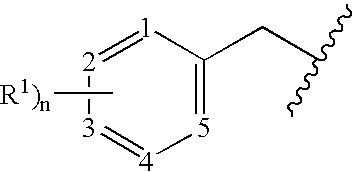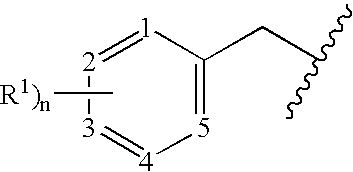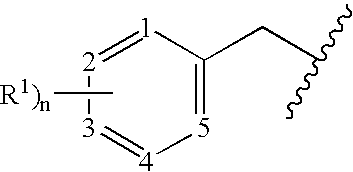Benzylated PDE4 inhibitors
- Summary
- Abstract
- Description
- Claims
- Application Information
AI Technical Summary
Benefits of technology
Problems solved by technology
Method used
Image
Examples
example 1
Formation of Benzylation Agent from Corresponding Benzyl Alcohol
[0311]
Synthesis of Compound 2
[0312] To a rapidly stirred slurry of 3-methoxy-4-hydroxybenzyl alcohol 1 (30.0 g, 195 mmol), potassium carbonate (62.2 g, 450 mmol), and 18-crown-6 (0.40 g, 1 mol %) in toluene (350 mL) was added a solution of benzyl bromide (BnBr, 25.6 g, 150 mmol) in toluene (150 mL) over 20 min. The reaction mixture was refluxed for 16 hours, after which the mixture was diluted with diethyl ether (400 mL) and washed successively with NaOH (1 N, 2×250 mL), saturated aqueous NaHCO3 (2×250 mL), and brine (2×300 mL). The diethyl ether layer was dried over anhydrous MgSO4, and the solvent was removed to provide a pale yellow solid (42.1 g) which was crystallized with EtOAc and hexanes to give compound 2 (32.7 g, 77%) as a white crystalline solid.
Synthesis of Compound 3
[0313] To a solution of alcohol 2 (3.20 g, 13.1 mmol) in anhydrous diethyl ether (15 mL) was added PBr3 (1.77 g, 6.55 mmol) in one portio...
example 2
Formation of Benzylation Agent from Corresponding Benzyl Aldehyde
[0314] Scheme 3 illustrates several procedures for converting commercially available benzyl aldehydes into the corresponding benzyl alcohol. Suitable solvents may be employed in any of these reactions.
Synthesis of Compound 14
[0315] To a suspension of 4-hydroxy-3-nitrobenzaldehyde 13 (3.00 g, 17.95 mmol), potassium carbonate (3.73 g, 26.93 mmol) in DMF (300 mL) was slowly added benzyl bromide (2.85 mL, 23.96 mmol). The reaction mixture was stirred at 65° C. for 18 hours. After cooling to room temperature, the mixture was diluted with water (140 mL) and extracted with diethyl ether (3×150 mL). The combined organic layers were washed with water (150 mL) and brine (150 mL). After drying over anhydrous MgSO4, filtration and evaporation of the filtrate in vacuo gave crude compound 14 (4.39 g, 95%) which was used for the next reaction without further purification.
Synthesis of Compound 15
[0316] Compound 14 (4.30 g, 16....
example 3
Formation of Benzylated PDE4 Inhibitor from Benzylation Agent and Corresponding Non-Benzylated Inhibitor
[0318] A. Benzylation using various halide compounds to provide the desired benzylated products may be achieved as shown in Scheme 4. In Scheme 4, compound 17 is benzylated with commercially available 3,4-difluorobenzyl bromide to give the desired compound 18 in 59% yield.
Synthesis of Compound 18
[0319] n-Butyllithium (2.5 M solution in hexanes, 0.56 mL, 1.40 mmol) was added to a solution of diisopropylamine (0.20 mL) in dry THF (10 mL) at −78° C. The mixture was stirred at −78° C. for 1 hour, then HMPA (0.33 mL, 1.91 mmol) was added, followed by addition of a solution of compound 17 (0.30 g, 1.27 mmol) in THF (3 mL). After 1 hour, a solution of 3,4-difluoro benzyl bromide (purchased from Aldrich Chemical Company, Inc., 0.32 mL, 2.54 mmol)) was added in one portion to the reaction, and the resulting mixture was stirred at −78° C. for an additional 4 hours. The excess base was ...
PUM
| Property | Measurement | Unit |
|---|---|---|
| Molar density | aaaaa | aaaaa |
| Molar density | aaaaa | aaaaa |
| Molar density | aaaaa | aaaaa |
Abstract
Description
Claims
Application Information
 Login to View More
Login to View More - R&D
- Intellectual Property
- Life Sciences
- Materials
- Tech Scout
- Unparalleled Data Quality
- Higher Quality Content
- 60% Fewer Hallucinations
Browse by: Latest US Patents, China's latest patents, Technical Efficacy Thesaurus, Application Domain, Technology Topic, Popular Technical Reports.
© 2025 PatSnap. All rights reserved.Legal|Privacy policy|Modern Slavery Act Transparency Statement|Sitemap|About US| Contact US: help@patsnap.com



